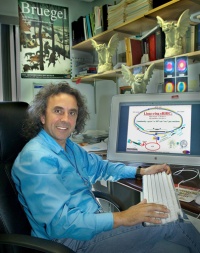User:VladimirLitvinenko
Vladimir Litvinenko, a physicist at the U.S. Department of Energy's Brookhaven National Laboratory, won the 2004 Free Electron Laser (FEL) Prize along with Hiroyuki Hama of Tohoku University, Japan. Sponsored by the International Free Electron Laser Conference to recognize outstanding contributions to FEL science and technology, the prize consists of a certificate and a plaque, and approximately $2,500 for each of the recipients. Litvinenko and Hama received their awards at the conference this month, which was held in Trieste, Italy. Photo of Vladimir Litvinenko
A free electron laser is a research tool that combines the focus of lasers and the intensity of synchrotrons, and it is useful in studying a wide variety of materials and chemical interactions. Litvinenko and Hama worked independently and were honored for separate contributions to the field.
"I am honored to accept the FEL Prize, which acknowledges my work at the Institute for Nuclear Physics in Russia and at Duke University," Litvinenko said. "I'd also like to thank my colleague, Igor Pinayev, for working along side me in Russia, at Duke, and now at Brookhaven Lab. His contributions were very important to my research in the FEL field."
Litvinenko and his team built a number of FELs based on the design of an optical klystron, an advanced version of an FEL. In 1988 and 1999, the team was the first in the world to extend the range of an FEL to the ultraviolet wavelength and to the vacuum ultraviolet, respectively. This work makes possible a wider variety of experiments in numerous scientific fields.
A theorist as well as an experimentalist, Litvinenko also was the first to develop the theory of storage-ring FELs, such as the one he and his team designed and built at Duke, with excellent agreement between theory and experiments. In addition, he invented and perfected "super-pulses" to generate very high power FEL light. These super-pulses increase sensitivity a thousand fold for nuclear physics experiments, and they are used in medical applications. Also, these super-pulses generate high harmonics, meaning they can provide photons for FEL experiments that have up to seven times more energy than usual. This improvement may lead to x-ray FELs - a powerful tool that may be used to study the structure of single biological molecules.
At Duke University, Litvinenko developed a high-intensity gamma ray user facility based on the storage ring FEL. This facility generated gamma ray beams of unprecedented quality and intensity, leading to new discoveries using an experimental technique called nuclear resonant fluorescence. The ability of this source to generate gamma rays in very pure form made it the ideal instrument to calibrate a gamma ray telescope to look at galaxies and observe supernovas.
Litvinenko earned his bachelor's and master's degrees in physics from Novosibirsk State University, Russia, in 1975 and 1977, respectively, and he earned his Ph.D. in physics and mathematics from the Institute for Nuclear Physics, Russia, in 1989. After working at the Institute for Nuclear Physics from 1973 to 1991, Litvinenko became a faculty member at Duke University in 1991. A frequent guest researcher at Brookhaven Lab, Litvinenko joined Brookhaven as a senior physicist in 2003, and he is currently head of the Accelerator Physics Group for Brookhaven's newest facility for nuclear physics research, the Relativistic Heavy Ion Collider. He also became an adjunct professor at Stony Brook University in 2003.
